Family tree





A family tree, or pedigree chart, is a chart representing family relationships in a conventional tree structure. The more detailed family trees used in medicine and social work are known as genograms.
Family history representations
Genealogical data can be represented in several formats, for example as a pedigree or ancestry chart. Family trees are often presented with the oldest generations at the top and the newer generations at the bottom. An ancestry chart, which is a tree showing the ancestors of an individual, will more closely resemble a tree in shape, being wider at the top than the bottom. In some ancestry charts, an individual appears on the left and his or her ancestors appear to the right. A descendancy chart, which depicts all the descendants of an individual will be narrowest at the top.
Family trees can have many themes. One might encompass all direct descendants of a single figure, or all known ancestors of a living person. Another might include all members of a particular surname (e.g. male-line descendants). Yet another approach is to construct a tree including all holders of a certain office, such as kings of Germany. This relies on dynastic marriage to hold together the links between dynasties.
The image of the tree probably originated with one in medieval art of the Tree of Jesse,[1] used to illustrate the Genealogy of Christ in terms of a prophecy of Isaiah (Isaiah 11:1). Possibly the first non-Biblical use, and the first to show full family relationships rather than a purely patrilineal scheme, was that involving family trees of the classical gods in Boccaccio's Genealogia deorum gentilium ("On the Genealogy of the Gods of the Gentiles"), whose first version dates to 1360.
Fan chart
One technique is a "fan chart", which features a half circle chart with concentric rings: the person of interest is the inner circle, the second circle is divided in two (each side is one parent), the third circle is divided in four, and so forth. Fan charts depict paternal and maternal ancestors.
Graph theory
While family trees are depicted as trees, family relations do not in general form a tree in the sense of graph theory, since distant relatives can mate, so a person can have a common ancestor on their mother's and father's side. However, because a parent must be born before their child is born, a person cannot be their own ancestor, and thus there are no loops, so ancestry forms a directed acyclic graph.
The graphs of matrilineal descent ("mother" relationships between women) and patrilineal descent ("father" relationships between men) are trees however.
Assuming no common ancestor, an ancestry chart is a perfect binary tree, as each person has exactly one mother and one father, for two parents; these thus have a regular structure. A descendancy chart, on the other hand, does not in general have a regular structure, as a person can have any number of children, or none at all.
Notable examples
The longest family tree in the world today is that of the Chinese philosopher and educator Confucius (551–479 BC), and he is the descendant of King Tang (1675–1646 BC). The tree spans more than 80 generations, and includes more than 2 million members. An international effort involving more than 450 branches around the world was started in 1998 to retrace and revise this family tree. A new edition of the Confucius genealogy was printed in September 2009 by the Confucius Genealogy Compilation Committee, to coincide with the 2560th anniversary of the birth of the Chinese thinker. This latest edition is expected to include some 1.3 million living members who are scattered around the world today.[2]
Another very old and extensive tree is that of the Lurie lineage—which includes Sigmund Freud and Martin Buber—and traces back to Jehiel Lurie, a 13th-century rabbi in Brest-Litovsk, and from there to Rashi and purportedly back to the legendary King David.
In Europe, the pedigree of Niall Noígíallach would be contender for the longest, through Conn of the Hundred Battles (fl. 123 AD).
Other uses
The author Pete Frame is notable for having produced "family trees" of rock bands. In this instance, the entries represent membership of certain groups, and personnel changes within them, rather than family relationships. Several books have been produced with his family trees,[3] which in turn have led to a BBC television series about them, including interviews from the bands depicted in the trees.[4]
See also
- Ahnentafel
- Cousin
- Genealogical numbering systems
- Genealogy software
- Genogram
- List of family trees
- Pedigree chart
- Tree of life (biology)
References
- ↑ Simon Julian Gilmour (2000) Daz Sint Noch Ungelogeniu Wort: A Literary and Linguistic Commentary on the Gurnemanz Episode in Book III of Wolfram's Parzival. Universitätsverlag Winter, 2000. p.64
- ↑ Confucius family tree has two million members from China Daily, unknown date, updated February 16, 2008
- ↑ "Amazon - Even More Rock Family trees". Retrieved 20 September 2012.
- ↑ "BBC Four : Rock Family Trees". Retrieved 20 September 2012.
External links
| Wikimedia Commons has media related to Family trees. |
- Family Tree Templates Examples of genealogy family tree charts.
| ||||||||||||||||||||||||||||||
| ||||||||||||||||||||||||||||||||||
| ||||||||||||||||||||||||||||||||||||||